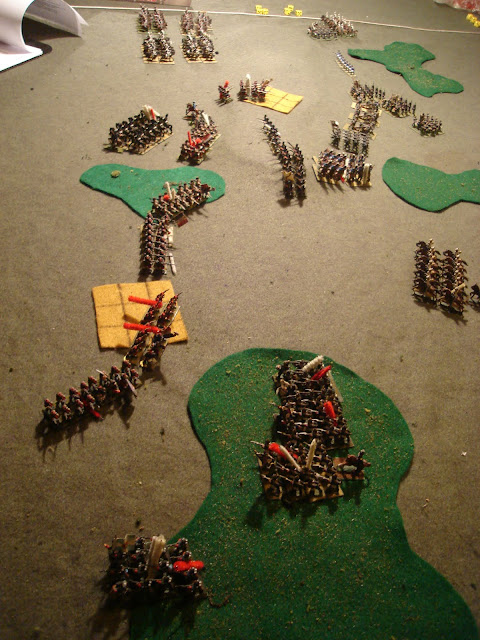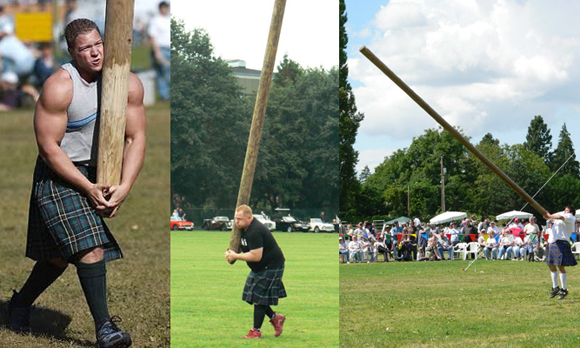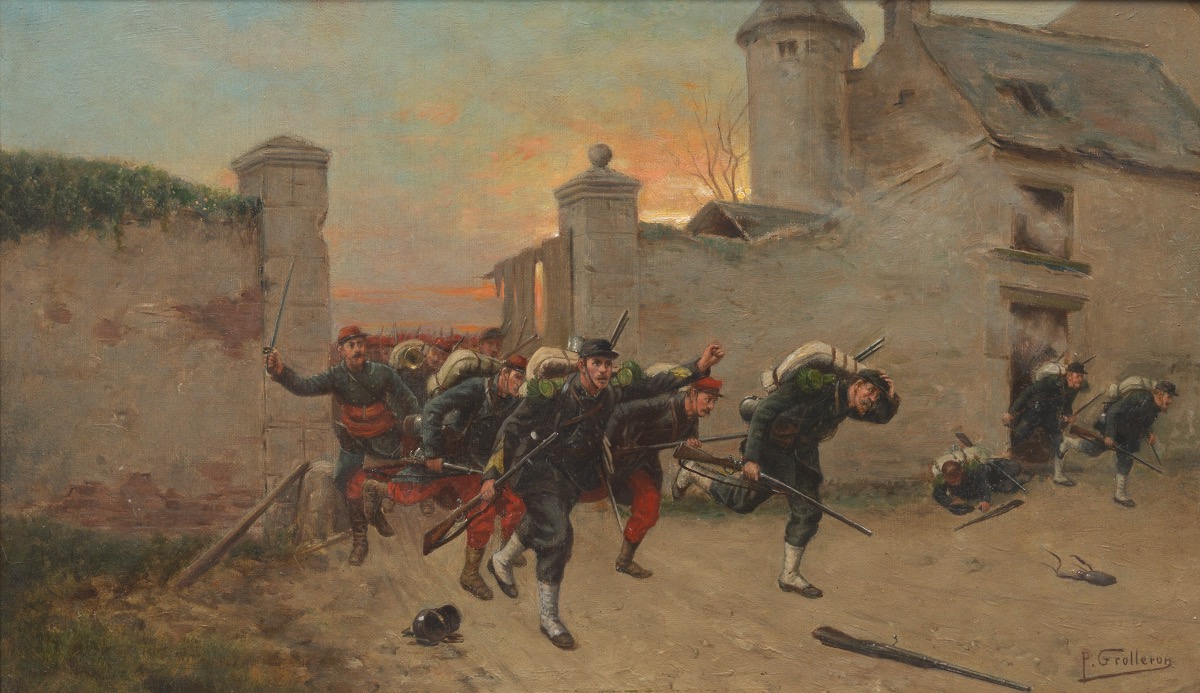
By Alphonse de Neuville, Public Domain, https://commons.wikimedia.org/w/index.php?curid=981845
The 3rd playtest was quickly played and very similar to the previous games, just some fine-tuning of the rules took place. I forgot completely to take any pics, so not much to record here! Also, I was super busy at the time, and didn't record events carefully.
This leads us to the 4th playtest, where, determined to take good pics, I even brought the tripod for the old Sony digitial cam.
This time, I wanted to have an all-out Prussian attack, since I was reading Howard's account of the battle of Saarbrucken, and was very curious if the game would play - generally - the way that battle went. We shall see...
Below, the battlefield is laid. French to left, must defend both towns successfully from the advancing Prussian horde to right. French have one weak infantry division and a strong cavalry division. Infantry Division is 3 Guard battalions and 3 Ligne battalions, two rifled muzzleloaders. Cavalry division is three brigades of 2 Units each, all regiments of hussars, dragoons and such, no guns.
This scratch French force is facing two Prussian brigades, a stronger one and a strong one. They respectively have 6 / 4 Infantry battalions, 2/1 Krupp guns, 1/1 Skirmishers and two Cavalry squadrons each. The stronger one is at bottom, the strong one at top. The French have the Guard at top and Ligne at bottom, with four cavalry at top and two lower, towards the center. Just visible is the ridge on which the Guard occupy a town.

French side. The 15mm show up pretty well despite the weak lighting. Flash makes it worse, interestingly. The center cavalry are cunningly placed so that they can charge up the hill or thru the narrow gap to the lower right of them, and therefore they can counter-attack in support of either brigade. The French batteries are out numbered and outclassed; c'est la vie! There is one in support of each brigade, directly next to each town.

In front of some French battalions is my special rule for the French: they can dig in, when in open terrain, and enhance their save by 1 to 4+. In the open it is 5+ and in woods it is 3+, so right between. The downside is that when dug-in, they count as Out of Command, and must roll to move - on a '1' they form up but don't exit their field works, showing the reluctance of the men to abandon their protection.
The other French rule is that their cavalry is brigaded together and has its own general - they won't listen to the Infantry General. Thus the French have larger, unified cavalry forces, but it is harder to coordinate them closely with the Infantry.
Prussians below, have a 10-6 superiority in Infantry Units, a 2-1 superiority in Skirmishers, and a 4-6 inferiority in Cavalry, but theirs are closely integrated with their Infantry brigades. The three Krupp batteries [about 6 guns ea., but one stand in this game] are at center, gathered together exactly between the two brigades. The four Infantry battalions are above them, and the two Cavalry regiments [white cuirassiers] are behind.

At the bottom of the pic, the six Infantry battalions are lined up, with one and a Skirmisher just behind the wood, with two Lt. Dragoons in blue at bottom and rear. The General is just above the cavalry.
View from the French lines: Hussars and two regiments of dragoons at bottom, three Guard Infantry and one battery next to the town. The Prussians only have three batteries a few Infantry and a Cavalry Unit poised to attack down the valley - pas de probleme, oui?

Right flank - an astonishing flash of lightening punctuates the overcast day - could this be an omen?? Superstitious Soldiers rub their rabbit feet. Three line battalions, one in the town, with the General and a battery between town and woods. Skirmishers to right. Their plan is to hold the wood and keep pressure off the town. The gun has a shorter range and is about half as effective as the Prussian Krupp guns, but has no opposing battery here.

The lightening fades away...a gloom from the overcast sky settles on the battlefield...

Turns 1-2. Prussians drop 24 dice, 4 per gun on each turn, against the French battery. The French have 4 dice back [they're about half as effective due to poorly designed shells]. The French take 3 Hits and are concerned about their only guns.

Turns 3-4. French General retreats battery off the hill and rally a Hit. French Guard to right take a beating from the bombardment, and similarly retreat off the hill, abandoning their field works. Guard in town do the same. Guard to right manage - of course - to roll a '1', and form up slowly and but fail to move off the hill, malhereusement...

A Lull comes over the battlefield; there's a few adjustments to the positions and the Guard rally the best they can [down to one Base loss ea. Infantry, 1 Hit on the guns].

Turn 9. Prussian left starts to move forward. French realize their battery is out of position, too far to the rear, and has very limited line of sight on the attacking Prussians.

Turn 10. The Guard shift left - this is a bit awkward due to the Cavalry, and I should have used the General to speed up the movement. Then again, I can't even place a battery well, so what do I expect!? Obviously, too much wine, women and song when I was supposed to be studying the tactics of my forefathers at St. Cyr. The problem is that the General has a 6" command radius, and I wanted to be certain to position the Ligne battalion on the woods edge, and that seemed more important than moving over the Guard. In any event, the Ligne Unit is a bit too cramped between the battery and the skirmishers - sacre bleu!

Turn 11. The French Cavalry General leads some dragoons into the valley to threaten the Prussian advance - but there are three Prussian squadrons opposing them! The French battery manages to inflict a stand loss upon one Prussian battalion at center. The Prussians keep shifting to the French right. The Skirmishers reposition themselves farther over.

Turn 11 different angle. The French continue to respond to the Prussian attack on their right - there is no movement at all upon their left, so nothing prevents them from doing so. The battery is in a valley between the hill and woods, and behind the military crest of the hill. The Guard are taking up positions in the woods. More French cavalry will advance later.

Turn 12, Prussians. The Prussians organize their Cavalry, but the forward dragoons left their flank exposed to the advancing French cavalry. The Skirmishers pour fire into a Prussian battalion, but it is ineffective [three Hits, three saves]. The Skirmishers can't hold.

Turn 12, French. With a resounding battle cry, "omelette du fromage!" the French cavalry charge into the exposed Prussian squadron. Chassepot and Artillery fire inflict another lost Base on the center Prussian battalion. Skirmish fire is ineffective [no Prussian Base loss]. In melee, the French drop eight dice to four and force the Prussians to retreat behind their other two Squadrons. The Guard form up in the woods. Strong center, weak flank...

Turn 13, Prussians. Both squadrons charge, including the dragoons into the exposed French flank, and of course they trounce the French who add insult to injury by completely missing with all four dice and not even winning against the Cuirassiers to their front! They are forced to retreat, blocking the Guard and guns behind them. Prussian Infantry charge and rout the Skirmishers, who disperse despite having elite morale. They took a Base loss in the melee, lost and retreated and failed morale for losing, losing their second Base, and are removed. The damaged Prussian battalion wisely shifts out of the Fire zone and the General moves to help them rally.

Turn 13, French. The French battalion in the woods is threatened on its flank, and decides to retreat. A second battalion leaves the town to attempt to hold in the woods, which are the key to the French position - within them, the Prussians have the same Range, and the same protection, as the French in the town, plus they've numbers on their side.

Turn 15. The Prussians begin forming up and advancing on the left. They re-organize their cavalry and push a Skirmisher and Infantry battalion forward at center. In the woods, they maneuver to both threaten French battalions and outflank them. The French bend their line back to protect their exposed right flank as long as possible. The Guard are have a difficult choice - shift back to the left to protect their town, or go farther right to hold at least one town. Both are difficult, and one must be more palatable than the other...

Turn 15. Prussians form up and advance against the other town. French Guard prepare to defend the town when the moment is right. Their guns have again retreated to reform after taking fire, this time from the Prussian Skirmishers. Skirmishers are a real nuisance to Artillery in this game - they've enough firepower to whittle them down quickly, forcing them to reposition out of their shooting range, which is a generous 3" farther than the line Units.

Turn 16. Prussian Advance continues. They get VERY close on the right and pressure the Center, also. The Guard are hard-pressed in the center.

Turn 17 and end. We ran out of time, but the Prussian attack on the right succeeded, causing the French right to fall back into the town and the open. With Prussian control of the woods, it is unlikely the outnumbered French can hold the town.
At Center, the Prussians are massing four Infantry, three batteries and a Skirmisher against the town. Opposing them is only one French battery and a Guard battalion, and the four French Cavalry, who won't do anything but delay the inevitable.
The French will have to retreat! Hmmm, Sedan looks like a good spot...

Tactical Assessment:
- Rules worked well - like an account of Saarbrucken. The Infantry are useful, the Guns when massed are a decisive force, and the Cavalry can be a useful support when used very intelligently. More use of them as dragoons should be made.
- Anyone opposing the Prussians would do well to take a page from the book of Wellington and deploy on the reverse slope or in the cover of woods!
- Per the historical analysis, the rapid shellfire of the modern guns had a strong suppressive effect - while not many casualties were caused, their long reach and the explosive shells were very discomfiting to the Soldiers. The Rally rules work well to present this; Battalions lose their edge, but not their ability to fight.
- Despite writing, re-writing and re-re-writing the rules, I didn't play the French very well. A few small mistakes cost me troops I could ill-afford to lose, and I was unable to take advantage of Prussian complacency on the left.
- The command rules worked very well - they present players with decisions and problems, but none are insurmountable and local initiative is more likely than not to occur.
- All the respective Unit types work according to the history - Infantry is certainly queen of the battlefield, but the Prussian Krupp batteries are themselves decisive unless French use terrain to minimize their effect.
- The rally rules work perfectly - most Units can withdraw and reform in the face of superior firepower, but they never get their edge back. This will reward players who plan and are thoughtful about their men, which is better history and better gaming.
Overall, I really enjoy playing the period and the rules are an enabler for historical tactics and game play, and are quick and easy to work with. A little tweaks may be left here and there, but they are sound and ready for "cold playtesting" with strangers.
The period is basically Napoleonics in color and flavor, but the firepower makes it feel more like colonials. Terrain is critical, as it provides the friction against which the firepower rubs and is limited. This makes for good game play that is neither like WWII nor like 1815, and provides a great intermediate set of historical challenges to the wargamer.
This will have to be a priority project for me in 2019!

































